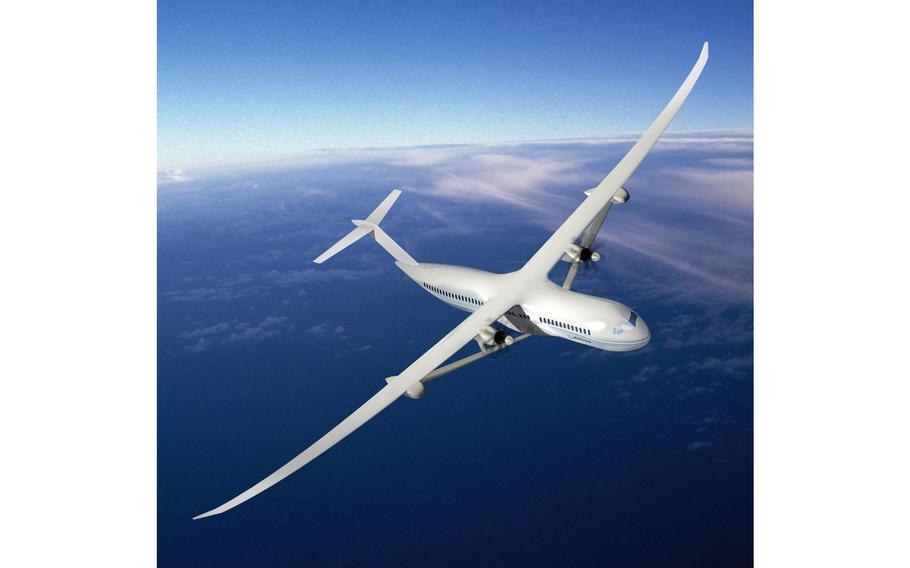
The Subsonic Ultra Green Aircraft Research, or SUGAR, Volt future aircraft design comes from the research team led by The Boeing Company. The Volt is a twin-engine concept with a hybrid propulsion system that combines gas turbine and battery technology, a tube-shaped body and a truss-braced wing mounted to the top of the aircraft. (NASA/The Boeing Company)
PARIS (Tribune News Service) — Facing the press on the eve of the Paris Air Show, Boeing Commercial Airplanes CEO Stan Deal confirmed Sunday that Boeing is seriously considering a specific innovation for its next new-design airplane that it will develop to enter service in the mid-to-late 2030s.
This is a new airframe configuration Boeing is developing with NASA called the Transonic Truss-Braced Wing, or TTBW.
Until the last few weeks, Boeing was publicly focused solely on fixing its recurring quality issues and dealing with supply chain shortages holding back a production ramp up. Now this concept that previously seemed far out has come into sudden focus.
"We have to look towards the future," Deal said.
At a parallel Airbus press event Friday in Paris, Chief Technical Officer Sabina Klauke described a series of early-stage research efforts into new wings and other innovations. Klauke didn't single any out, as Deal did, as expected to be ready soon for prime time.
If adopted, the design innovation would give airliners a distinctive new look.
While no decisions have yet been made, Deal said Boeing is already deep into an assessment of the new airframe design.
His comments follow on those of his boss, Boeing CEO Dave Calhoun, who earlier this month said the TTBW could be ready to use on the next all-new jet.
The aircraft will have very long, slender wings attached high on the fuselage.
The wings are so long, they have to be supported by trusses or struts anchored at the base of the fuselage and angling out and up to the wing.
Toward the wingtip, beyond where the truss meets the wing, it's likely the wing will have to fold to allow it to fit into the same gates as today's aircraft that fly domestically, such as the 737.
The long, aerodynamic wings produce great fuel efficiency and correspondingly lower carbon emissions. With pressure to cut aviation emissions mounting, especially in Europe, the next new airplane will have to achieve 20% or more better fuel efficiency than today's airplanes.
For the next big milestone in the project, Boeing will convert an old MD-90 airframe into a full-scale version of the TTBW that it aims to fly in 2028.
The Air Force has given the plane an official X-plane designation used for new experimental steps forward in aviation. The TTBW will be the X-66A.
NASA is providing $425 million in funding for the project while Boeing and its industry partners contribute $725 million.
Deal said Boeing has done extensive analysis and wind tunnel tests of small-scale models of the new configuration. The full-scale flight tests will tell engineers how that data meshes with reality.
Deal added that a host of other innovations are also being studied simultaneously, including new advanced materials for making the wing, a new high-volume production system and every aspect of design and production engineered with digital models.
Can all that really come together quickly?
Deal was asked if it's realistic to plan for a radically different, all-new airliner design to carry passengers only a few years after a first experimental flight in 2028, in addition to radically changing the production systems and the tools used to implement the design.
Deal pointed to all the analysis and testing Boeing and NASA have already done.
"That's why we're investing now," he said. "We're not in day one. We're actually many years in."
Asked if Airbus has any such new airframe concept in the works, Chief Technical Officer Sabina Klauke responded that the European jet maker is constantly conducting lots of research.
Airbus has "many technologies which we're maturing at the very moment in order to be ready for anything," she said. "There is work on new materials, there is work on wings, there is work on the different engine concepts."
She said many of the ingredients are similar to elements of the TTBW.
She mentioned one Airbus project called the Wing of Tomorrow, which is using smaller-scale models to study long, aerodynamically efficient wings.
"We are looking into an extra large wing, which would be foldable and it will even be foldable in the air," Klauke said.
That idea is in part to smooth out the lift coming from the wings by folding them out to become larger in thinner air.
But no one seems to be thinking of this as imminent technology, something we could all fly on in just over a decade. There's no word of a full-scale European X-plane in the works in the near future.
Yet if Boeing's test flight program in 2028 bears out the promise of the technology, Airbus will certainly follow with its own variant.
(c)2023 The Seattle Times
Visit www.seattletimes.com
Distributed by Tribune Content Agency, LLC.